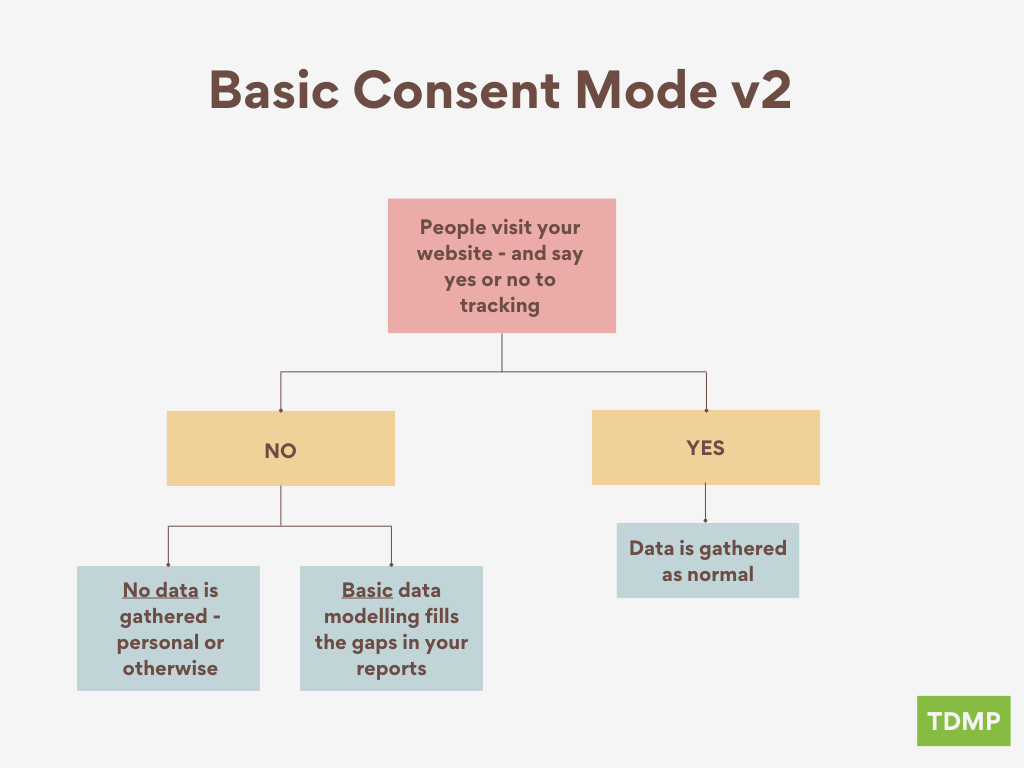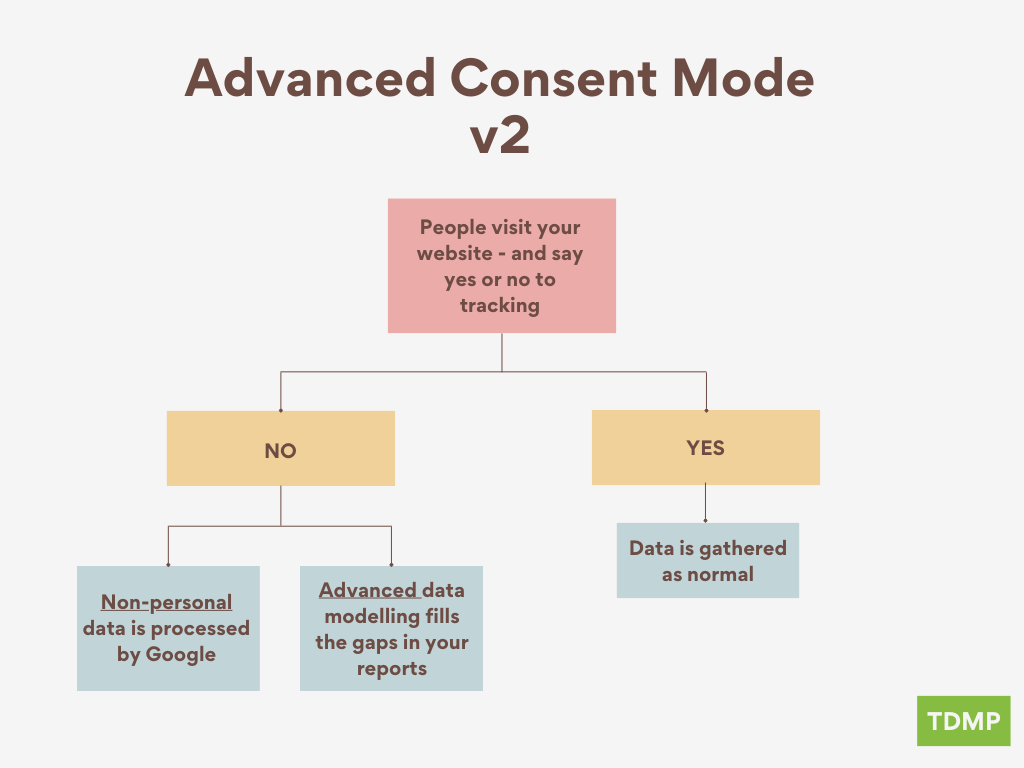At the end of last year Google announced that Consent Mode v2 will be required by March 6th, 2024 – and website owners operating within Europe would need to ensure changes were implemented in order to prevent any impact to other Google tools such as Google Ads and Google Analytics.
It was then confirmed in January 2024, that this change to consent mode would be required of businesses operating in the UK also.
In this comprehensive guide, we delve into the intricacies of Google Consent Mode v2. From understanding its core functionalities to outlining the steps to take to ensure compliance.
Overview in brief
- The deadline for implementing Google Consent Mode v2 is March 6th, 2024.
- Implementing the changes required by Google Consent Mode v2 is mandatory in order to maintain consistent data collection for performance analysis and optimisations.
- Non-compliance with Google Consent Mode v2 will result in less effective ad campaigns.
What is Google Consent Mode?
Google Consent Mode was developed in order to allow for the measuring of conversions and gathering of website insights, whilst respecting a visitor's cookie consent choices. If a user does not consent to a website’s cookie policy – Google Consent Mode allows a website to recover lost conversions by filling in the gap in data using modelling.
With GCM implemented, users who consent are treated as normal, i.e., all data regarding how they interact with the website is gathered to be used to inform ad campaign performance, Google Analytics, and other Google tools.
With GCM implemented, users who do not consent to cookies will only generate anonymous data. GCM provides enough information to keep the website functional in terms of user experience, but no personal data is passed on for targeted advertising purposes after the fact.
In other words, GCM provides a straightforward and automated way for site owners and advertisers to respect user privacy whilst still collecting important data – such as website usability insights or ad campaign traffic performance.
What's new in Google Consent Mode v2?
GCM v2 has been updated to reflect recent developments in European privacy legislation.
GCM v1 was focused on increasing user privacy in relation to collected and stored data, while GCM v2 encourages compliance with legislation relating specifically to data used for targeted advertising.
Google Consent Mode v2 permits the use of data modelling to support remarketing and ad personalisation, thereby improving campaign performance, in a compliant manner. Those who choose not to implement GCM v2 by March 2024 will be unable to gather any data related to new UK or EEA users via Google advertising platforms, such as Google Ads and Analytics.
This means:
- You will not have the necessary data to conduct remarketing aimed at new UK or EEA users.
- Google’s algorithm will not have access to the data required to track or predict your conversions accurately.
- You will have significantly less data to guide Google Ads performance optimisations.
Implementation requires some technical changes (see appendix), but notably, you’ll need to update the language used on your cookie banner, so it aligns with Google’s new privacy standards.
Additionally, you will need to update your privacy policy to ensure it provides a clear and accurate description of how you will be obtaining user consent and handling user data moving forward.
What do I need to do?
You need to update your site’s consent mode and cookies policy. If you have active Google Ads you need to ensure this is completed by the 6th of March 2024.
Please see the appendix for guidance on how to do this – if you use a Consent Management Platform and if you do not.
Enabling GCM v2 is essential if you want to:
- Stay compliant with current EU privacy legislation (and perhaps future UK-specific privacy legislation), thereby safeguarding against penalties and potential legal action.
- Collect valuable data related to new UK and EEA users interacting with your website or ads.
- Run effective ad campaigns.
We also highly recommend setting up Consent Mode v2 in advanced mode. You can do this via Google Tag Manager. Advanced mode enables Google to gather anonymised data even if users deny consent. This supports the modelling of user behaviours and conversions.
Bottom line
With limited guidance from Google, as well as an abundance of misinformation online, learning about and implementing GCM v2 can be challenging. However, the consequences of getting it wrong may be severe! Contact us if you have any doubts about what GCM v2 means or how to implement it correctly — we'll guarantee compliance and effective post-deadline measurement.
Appendix
How to implement Google Consent Mode v2
To implement Google Consent Mode v2, you’ll need to make changes to your tracking tags and cookie policy.
You use a Consent Management Platform (CMP)
If you use a Google certified Compliance Management Platform (CMP) such as Cookiebot or OneTrust – you should not have to make any changes to your site’s Google Tag Manager, or backend.
Google certified CMPs should do this automatically. Even so, we recommend you follow-up with your provider in order to discuss if your cookie policy, or cookie banner wording needs to be updated in order to recognise the changes.
You do not use a Google Certified Consent Management Platform (CMP)
If you do not use a Google certified CMP – but you already have consent mode set up, all you need to add is 2 new variables via Google Tag Manager:
- ad_user_data
- ad_personalization
As mentioned above, you will also need to make sure your cookie policy and cookie banner text is updated in order to recognise these changes.
New parameters in Google Consent Mode v2
GCM v2 supports the collection of consent on a granular scale by introducing two additional parameters:
- ad_user_data:
The ad_user_data parameter in Google Consent Mode v2 determines whether personal data is sent to Google services (such as Google Ads, Google Shopping, etc) for advertising purposes based on user consent. This parameter can have two values, "granted" or "denied," depending on whether a user gives consent.
If a user agrees to advertising cookies on the cookie banner, thus consenting to share their data with Google, ad_user_data will be set to "granted." However, this functionality is contingent on the banner’s language aligning with Google’s standards for compliance.
- ad_personalization:
The ad_personalization parameter in GCM v2 governs the use of personal data for activities such as remarketing. Much like ad_user_data, ad_personalization offers two potential values based on user consent: "granted" or "denied."
When a user consents to advertising cookies via the cookie banner, allowing their data to be used by Google for ad personalisation, the ad_personalization parameter is set to "granted."
Again, though — this is reliant on the banner's language reflecting Google's compliance standards.
Should I choose basic consent mode or advanced consent mode?
Google Consent Mode v2 provides two options for implementation:
- Basic consent mode
- Advanced consent mode
As mentioned earlier, we suggest opting for advanced consent mode for enhanced data modelling.
Read on for more information about your two options.
Basic consent mode
With basic consent mode, a website functions normally when a user accepts cookies; all tags are activated, and all data is collected. On the other hand, no information is collected if a user refuses to provide consent.
Google will attempt to fill the gap left by basic consent mode by modelling data. This means that Google's algorithms will estimate how users who refused consent are interacting with your ads or website based on how users who did give consent are interacting with your ads and website.
The below flow chart illustrates the basic consent mode process:

Basic consent mode enables conversion modelling in both Google Ads and Google Analytics; however, it will be based on Google's general data models, meaning the results won't be as precise as they could be.
Another drawback to the basic mode is that it blocks behavioural modelling in Google Analytics, meaning you won't be able to fill as many data gaps left in reports by non-consenting users.
Advanced Consent Mode
For the most part, advanced consent mode behaves similarly to its basic counterpart, but with one notable advantage.
When users decline cookie consent on your website, advanced consent mode permits the sending of anonymous, “cookieless” pings to Google.
This means that any non-personal data relating to how non-consenting users interact with your ads or website is still carried through to your Google tools where it can be used to enhance the data modelling process.
Non-personal data includes:
- Device type
- Browser
- Conversion type
- Location (country)
- Time of conversion
This results in more accurate accounts of non-consenting user activity, giving you more insights to work with when optimising your website or marketing campaigns.
Furthermore, unlike basic mode, advanced consent mode enables behavioural modelling in Google Analytics, leading to fewer gaps in your reports — and more insights to drive website optimisations.
The below flow chart illustrates the advanced consent mode process:

Final thoughts
Google Consent Mode v2 is a sudden pivot in how user consent and data is handled and processed, but by enabling this new mechanism before the March deadline, you ensure that its real-world impact on your website and marketing activities is minimal.
With the GCM v2 deadline looming, the time to reach out is now! Contact TDMP to ensure compliance, avoid potential post-deadline penalties, and seek support for your future digital marketing endeavours.

